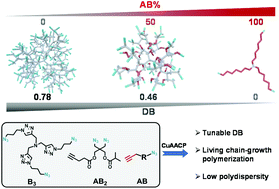Chain-growth click copolymerization for the synthesis of branched copolymers with tunable branching densities†
Abstract
In this work, we reported a facile synthesis of (hyper)branched copolymers with a tunable degree of branching (DB) via one-pot chain-growth copper-catalyzed azide–alkyne cycloaddition (CuAAC) reactions. By using a tri-azido core molecule as an initiator, a variety of difunctional AB monomers with different linkers were designed for CuAAC copolymerization with a trifunctional AB2 monomer to produce a series of branched copolymers with tunable compositions and low dispersity. Kinetics studies and chain-extension experiments confirmed the features of the chain-growth mechanism and living polymerization. Although AB2 monomers showed a higher homopropagation rate than AB monomers, their copolymerization consumed AB monomers slightly faster than AB2 monomers probably due to their steric difference. The incorporation of pH-responsive and redox-responsive linkages into AB monomers allowed the stimuli-responsive degradation of branched copolymer structures into fragments. Preliminary studies indicated that branched polymers with lower DBs showed a higher loading capacity than hyperbranched polymers from the homopolymerization of AB2, demonstrating the dependence of the payload encapsulation efficiency on polymer structure compactness. This exploration expanded our toolbox to tune the composition and structures of (hyper)branched polymers for their potential application as unimolecular nanocontainers.

- This article is part of the themed collection: Polymer Chemistry Recent HOT Articles


 Please wait while we load your content...
Please wait while we load your content...
